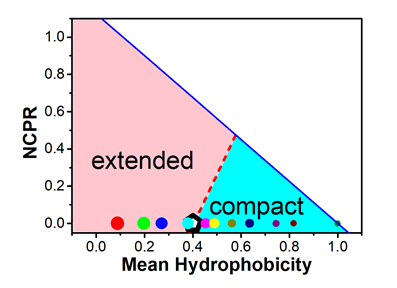[1] Kister, A. E.; Potapov, V. Biochem. Soc. Trans. 2013, 41, 616.
[2] Sadowski, M. I.; Jones, D. T. Curr. Opin. Struct. Biol. 2009, 19, 357.
[3] Shenoy, S. R.; Jayaram, B. Curr. Protein Pept. Sci. 2010, 11, 498.
[4] Chu, X.; Gan, L.; Wang, E.; Wang, J. Proc. Natl. Acad. Sci. U. S. A. 2013, 110, E2342.
[5] Daggett, V.; Fersht, A. Nat. Rev. Mol. Cell Biol. 2003, 4, 497.
[6] Daggett, V.; Fersht, A. R. Trends Biochem. Sci. 2003, 28, 18.
[7] Dinner, A. R.; Sali, A.; Smith, L. J.; Dobson, C. M.; Karplus, M. Trends Biochem. Sci. 2000, 25, 331.
[8] Leelananda, S. P.; Jernigan, R. L.; Kloczkowski, A. J. Comput. Biol. 2016, 23, 400.
[9] Li, H.; Helling, R.; Tang, C.; Wingreen, N. Science 1996, 273, 666.
[10] Matouschek, A.; Serrano, L.; Fersht, A. R. J. Mol. Biol. 1992, 224, 819.
[11] Onuchic, J. N.; Luthey-Schulten, Z.; Wolynes, P. G. Annu. Rev. Phys. Chem. 1997, 48, 545.
[12] Schug, A.; Onuchic, J. N. Curr. Opin. Pharmacol. 2010, 10, 709.
[13] Wang, J.; Wang, W. Nat. Struct. Biol. 1999, 6, 1033.
[14] Wang, J.; Wang, W. Adv. Phys. X 2016, 1, 444.
[15] Wolynes, P. G. Biochimie 2015, 119, 218.
[16] Apicella, A.; Marascio, M.; Colangelo, V.; Soncini, M.; Gautieri, A.; Plummer, C. J. J. Biomol. Struct. Dyn. 2017, 35, 1813.
[17] Dyson, H. J.; Wright, P. E. Nat. Rev. Mol. Cell Biol. 2005, 6, 197.
[18] Gao, M.; Yang, F.; Zhang, L.; Su, Z.; Huang, Y. J. Biomol. Struct. Dyn. 2018, 36, 1171.
[19] Jain, A.; Ashbaugh, H. S. J. Chem. Phys. 2008, 129, 174505.
[20] Kang, W. B.; He, C.; Liu, Z. X.; Wang, J.; Wang, W. J. Biomol. Struct. Dyn. 2019, 37 1956.
[21] Khan, S. H.; Jasuja, R.; Kumar, R. J. Biomol. Struct. Dyn. 2017, 35, 2248.
[22] Migliaccio, A. R.; Uversky, V. N. J. Biomol. Struct. Dyn. 2018, 36, 1617.
[23] Oldfield, C. J.; Dunker, A. K. Annu. Rev. Biochem. 2014, 83, 553.
[24] Singh, I.; Singh, S.; Uversky, V. N.; Chandra, R. J. Biomol. Struct. Dyn. 2017, 1.
[25] Uversky, V. N.; Oldfield, C. J.; Dunker, A. K. Annu. Rev. Biophys. 2008, 37, 215.
[26] Yacoub, H. A.; Al-Maghrabi, O. A.; Ahmed, E. S.; Uversky, V. N. J. Biomol. Struct. Dyn. 2017, 35, 836.
[27] Uversky, V. N. Protein Sci. 2002, 11, 739.
[28] Uversky, V. N.; Gillespie, J. R.; Fink, A. L. Proteins 2000, 41, 415.
[29] Das, R. K.; Pappu, R. V. Proc. Natl. Acad. Sci. U. S. A. 2013, 110, 13392.
[30] Mao, A. H.; Crick, S. L.; Vitalis, A.; Chicoine, C. L.; Pappu, R. V. Proc. Natl. Acad. Sci. U. S. A. 2010, 107, 8183.
[31] Kang, W. B.; Wang, J.; Wang, W. Acta Phys. Sin. 2018, 67, 058701.
[32] Yue, K.; Dill, K. A. Proc. Natl. Acad. Sci. U. S. A. 1995, 92, 146.
[33] Ashbaugh, H. S.; Asthagiri, D. J. Chem. Phys. 2008, 129, 204501.
[34] Ashbaugh, H. S.; Hatch, H. W. J. Am. Chem. Soc. 2008, 130, 9536.
[35] Vitalis, A.; Pappu, R. V. J. Comput. Chem. 2009, 30, 673.
[36] Vitalis, A.; Pappu, R. V. Annu. Rep. Comput. Chem. 2009, 5, 49.
[37] Jiang, P.; Yasar, F.; Hansmann, U. H. J. Chem. Theory Comput. 2013, 9, 3816.
[38] Mitsutake, A.; Okamoto, Y. Phys. Rev. E Stat. Nonlin Soft Matter Phys. 2009, 79, 047701.
[39] Nanias, M.; Czaplewski, C.; Scheraga, H. A. J. Chem. Theory Comput. 2006, 2, 513.
[40] Yoda, T.; Sugita, Y.; Okamoto, Y. Proteins 2007, 66, 846.
[41] Kyte, J.; Doolittle, R. F. J. Mol. Biol. 1982, 157, 105.
[42] Das, R. K.; Crick, S. L.; Pappu, R. V. J. Mol. Biol. 2012, 416, 287.
[43] Pappu, R. V.; Wang, X.; Vitalis, A.; Crick, S. L. Arch. Biochem. Biophys. 2008, 469, 132.
[44] Jin, F.; Liu, Z. R.; Biophys. J. 2013, 104, 488.
[45] Ruff, K. M.; Pappu, R. V.; Holehouse, A. S. Curr. Opin. Struct. Biol. 2019, 56, 1.
[46] Choi, J. M.; Dar, F.; Pappu, R. V. PLOS Comp. Biol. 2019, 15, e1007028.
[47] Zhou, H. X.; Nguemaha, V.; Mazarakos, K.; Qin, S. B. Trends Biochem. Sci. 2018, 43, 499.
[48] Dignon, G. L.; Zheng, W. W.; Best, R. B.; Kim, Y. C.; Mittal, J. Proc. Natl. Acad. Sci. U. S. A. 2018, 115, 9929.
[49] Uversky, V. N. Curr. Opin. Struc. Biol. 2017, 44, 18.
[50] Zhang, P. C.; Fang, W. Y.; Bao, L.; Kang, W. B. Acta Phys. Sin. 2020, 69, 138701(in Chinese). (张鹏程, 方文玉, 鲍磊, 康文斌, 物理学报, 2020, 69, 138701.)
[51] Wang, G. C.; Cui, Y. B.; Sun, Y. H.; Zhong, B. Acta Chim. Sinica 1998, 56, 867(in Chinese). (王贵昌, 崔永斌, 孙予罕, 钟炳, 化学学报, 1998, 56, 867.)
[52] Cao, D. P.; Wang, W. C.; Duan, X.; Jiao, Q. Z. Acta Chim. Sinica 2001, 59, 297(in Chinese). (曹达鹏, 汪文川, 段雪, 矫庆泽, 化学学报, 2001, 59, 297.)
[53] Wang, D. C. Protein Engineering, Vol. 1, Chemical Industry Press, Beijing, 2008, p. 65(in Chinese). (王大成, 蛋白质工程, 化学工业出版社, 北京, 2008, p. 65)
[54] Deng, H. Y.; Jia, Y.; Zhang, Y Acta Phys. Sin. 2016, 65, 178701(in Chinese). (邓海游, 贾亚, 张阳, 物理学报, 2016, 65, 178701.) |
